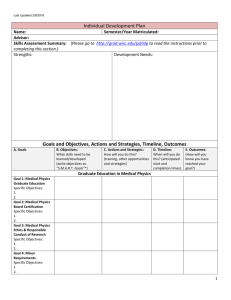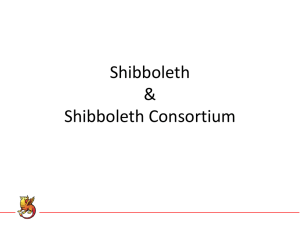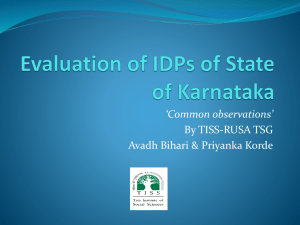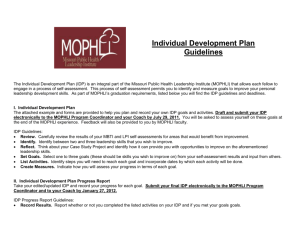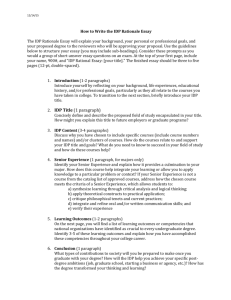20120425-Bellina-Shibboleth
advertisement
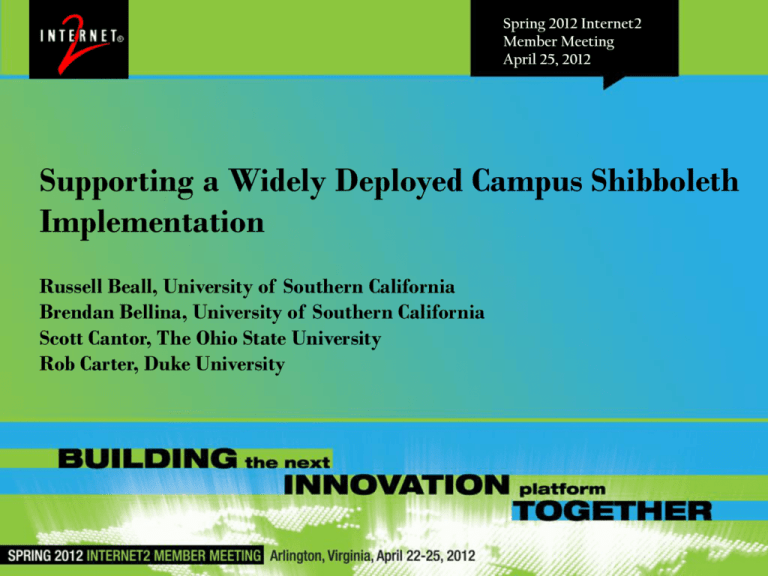
Spring 2012 Internet2 Member Meeting April 25, 2012 Supporting a Widely Deployed Campus Shibboleth Implementation Russell Beall, University of Southern California Brendan Bellina, University of Southern California Scott Cantor, The Ohio State University Rob Carter, Duke University A modern fable… 2 – © 2012 In the Beginning there was the Shibboleth IdP… Shibboleth IdP And it was Good. And readily supported. 3 – © 2012 And some Central Services came to be integrated with the Shibboleth IdP… Portal LMS IdP Wiki Developed Apps And it was Good. And Support was small and managed. 4 – © 2012 And then many Department Services were integrated with the Shibboleth IdP… Central Services Library Medical Registration IdP Law HR More Developed Apps And it was still Good. Though Support was strained. 5 – © 2012 And then even External Providers were integrated with the IdP… Google Department Services Central Services EzProxy Lynda.com ExLibris Aetna Sharepoint IdP TeraGrid SciQuest CollegeNet Digital Measures And many, many more And it was Still Good. And then Support … 6 – © 2012 7 – © 2012 This could be you. 8 – © 2012 Some (not all) Things to Consider • Applications may be central, departmental, or externally hosted • Applications may be internally developed, open source, or vendor developed. • Applications may require user provisioning just-in-time or ahead of time. • Applications may not handle identifier changes well or at all. • Applications may not allow merges. • Departments may lack permanent staff for SP Support and expertise. Staff may leave and they may have relied upon contractors to establish the service. • Expectation of 24x7x365 support for web applications accessible from any time zone. • The technology scales, but does your support infrastructure? 9 – © 2012 The Ohio State University 10 – © 2012 University Environment 65,000 students, 28,000 employees 160,000 unique accounts Various “traditional” populations like alumni not given access to most campus services IT functions highly distributed Minimal funding/support of centralized infrastructure Shibboleth in production since 2004 IdP Environment Upgraded to 2.x last summer, also moved from Apache+Tomcat to Jetty Two Linux servers at separate data center locations, lots of CPU, low on RAM No clustering, deployed with extensions for attribute query handling and SSO via cookie IdP sessions are short-lived, traffic is pinned during user login sequence ~150,000 – 350,000 logins per day SP Environment 15-20 off-campus SPs, mostly InCommon members ~250 on-campus SPs Largely manual, email-based registration and change management process “Trusted” customers with larger deployments maintaining their own signed metadata files for import by IdP Support Model Had .25 FTE dedicated to operating the IdP and supporting SPs, bumped to .75 FTE for staffing redundancy Minimal local support for SP deployment, most questions directed to public lists Initial configuration files tailored to OSU environment provided with custom documentation on what to change University of Southern California Shibboleth Support Model Brendan Bellina Manager Enterprise Identity Management Information Technology Services University of Southern California Los Angeles, California, USA bbellina@usc.edu Russell Beall Senior Programmer/Analyst Information Technology Services University of Southern California Los Angeles, California, USA beall@usc.edu University Environment 42,000 students; 17,500 employees; 4800 affiliates 92,000 Shibboleth-enabled accounts Includes legacy student accounts retained for Google Apps IT infrastructure: moderately funded for centralized services Highly distributed departmental IT functions as well 16 IdP Environment 2.x since late 2007 Terracotta clustering since late 2008 Two Sun v440 machines in the cluster Two zones on Sun 5240 machines in DR IdP sessions last 8 hours Some services using short SP sessions and forceAuthn 30K-60K authentications per day 40K-100K service logins per day 17 SP Environment 100+ on-campus SPs, soon to be 130+ 29 off-campus SPs Governance process required for registration Requirements meeting(s) to document requirements Formal campus IT-leader committee approval required Blanket attribute release disallowed (perhaps until uApprove) Each SP generally has different access groups and attributes anyway 18 Support Model - Resources 0.5 FTE dedicated to IdP support and managing SP integration into the IdP SP admin group (small fraction of their time) for support of centralized SPs Departments and vendors responsible for supporting their SP deployments 2 FTE outside of central ITS assist in managing and documenting requests and governance Most user issues handled directly by CSC 19 Support Model – Docs and Tools Full-fledged “start-here” document with configuration generator application specialized to USC environment. http://shibboleth.usc.edu USC email lists for Shibboleth IdP Admins, SP Admins, and Announcements. SP Admins are required to be on the lists. Internally developed tool for displaying what attributes are released for a specific user to a specific SP. Helps when troubleshooting access issues. 20 Support Model - Policies Entitlement based authorization rather than attribute based. Entitlement assigned based on group memberships with a delegated tool for group administration for exceptions. Require department applications that consume USCID to also consume Historical USCID. Restrict release of non-persistent identifiers such as NetID, and instead release persistent identifiers. No undocumented changes are made. 21 Duke University 22 – © 2012 Tourist Information ❖ University + Academic Health System + hospitals & clinics ❖ 6500 ugrad, 8500 grad, 3200 faculty, 30,000 staff (mostly in Health System) ❖ Counting alumni & affiliates, over 78,000 active accounts, 490,000 total identities (active & inactive) IT Environment ❖ Roughly 50/50 central/departmental IT staff ❖ Central IT incorporates both OIT (spanning entire enterprise) and DHTS (Health System Central IT) ❖ PeopleSoft Student system & SAP HR/Payroll ❖ Traditional “free for all” in web space -- all clients/servers welcome IAM Environment ❖ Kerberos since early 1990s ❖ LDAP since ca. 2002 ❖ ERP linkages since early 2000s ❖ WebISO since early 2000s, starting with homegrown Webauth, transitioned to Shibboleth ca. 2005 ❖ Grouper site since ca. 2005, now with >> 350,000 groups ❖ OIM since ca. 2008 Shibboleth IDP Environment ❖ IDP 2.x running atop Centos Linux systems w/ Apache + Tomcat + Terracotta ❖ 4 production primary IDPs w/ hw load balancing ❖ 2 Terracotta clusters -- one pair active at a time ❖ Dedicated LDAP attribute repository (3-way multimaster Oracle/Sun LDAP server farm) ❖ Back-end authN via Kerberos 5, integrated OpenID gateway, optional multifactor interface Shibboleth IDP Environment ❖ Additional, unfederated dedicated IDPs for some internal purposes ❖ 50,000 - 120,000 logins per day (mean: 60,000) in primary IDPs, far less in unfederated internal IDPs Shibboleth SP Environment ❖ 850 distinct SPs entity IDs registered (in local-sites.xml) ❖ 750 in full production, ca. 100 in test or ppt ❖ all but 40 are local -- roughly 1/3 of those are “cloud” services (SaaS) ❖ Growth rate has increased dramatically since late 2010, when we deployed current SP support tools... 450 SPs registered between 2005 and 2011, 400 in 2011-2012 so far... SP Owner Support Infrastructure ❖ Shibbolized web site for managing local SP registrations ❖ Owners authN with their NetIDs then see the SPs they’ve registered (or been designated as admins for) and can edit or add new registrations ❖ Optionally produces SP configuration XML based on basic information and some reasonable defaults ❖ Registrations complete in real-time -- usually up and running within a minute or two of clicking “create” IDP Support Web Site SP Infrastructure (cont’d) ❖ SP owners can register/deregister entirely via self-service in most cases; many can get their entire SP config from the tool ❖ Default ARP passes ePPN and ePA (for unfederated SPs); handful of attributes considered “public” can be added in real-time through the self-service interface; others require approval ❖ If a registration involves restricted attributes, the request is processed without, then when approved, ARP is updated ❖ Note: This ONLY applies to local, not InCommon, SPs Questions 38 – © 2012 Contacting the Authors: Brendan Bellina, USC bbellina@usc.edu Russell Beall, USC beall@usc.edu Scott Cantor, OSU cantor.2@osu.edu Rob Carter, Duke robert.carter@duke.edu 39 – © 2012

